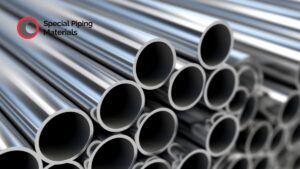At Special Piping Materials (SPM), innovation, quality, and sustainability are central to everything we do. As industries across the globe work to reduce carbon emissions and operate more responsibly, the materials used in piping systems are evolving too. One of the most significant developments is the emergence of green steel, leading to what is now commonly referred to as green steel pipe, or just simply ‘green pipe’.
Green steel pipe combines the proven performance of traditional steel with a lower environmental impact, offering a forward-looking solution for industries under increasing pressure to meet sustainability targets.
“Green steel represents an exciting step forward for the piping industry. It allows our clients to maintain the highest standards of quality while significantly reducing the environmental impact of their projects.”
– Alex Forth, Managing Director, Special Piping Materials
What Is Green Steel Pipe?
Green steel pipe is manufactured from low-carbon or near-zero-carbon steel. Unlike conventional steel production, which relies on coal or coke in blast furnaces and emits large amounts of CO₂, green steel uses cleaner energy sources and alternative production processes.
The steel itself performs in exactly the same way as traditional steel, meaning that strength, durability, and corrosion resistance remain uncompromised. The difference lies in how the steel is produced — with far lower carbon emissions and a significantly smaller environmental footprint.
How Green Steel Is Made
Green steel production relies on a combination of innovative technologies:
- Hydrogen-based reduction: This process replaces coal-based reduction with green hydrogen, produced using renewable energy. When iron ore is reduced using hydrogen, the only by-product is water vapour rather than carbon dioxide.
- Electric Arc Furnaces (EAFs) with recycled scrap steel: EAFs melt recycled steel scrap using electricity from renewable sources, dramatically reducing carbon emissions compared with traditional blast furnace methods.
- Carbon Capture and Storage (CCS): Some traditional blast furnaces are being adapted with CCS technology to capture CO₂ emissions before they are released into the atmosphere, further reducing the overall environmental impact.
These methods, whether used individually or in combination, allow green steel pipe to maintain the technical properties of conventional steel, while offering environmental benefits that align with modern sustainability goals.
Applications and Industry Relevance
Green steel pipe is particularly suited to industries where performance and sustainability are both critical. It can be used across a broad range of sectors, including:
- Energy and power generation: Natural gas, LNG, hydrogen infrastructure, and low-carbon power plants.
- Petrochemical and chemical processing: High-specification piping for demanding operational environments.
- Renewables and carbon capture projects: Supporting the construction of sustainable energy solutions.
- Mining and industrial applications: Durable, reliable pipe for heavy-duty use.
- Water treatment and infrastructure: Reducing the environmental impact of essential public utilities and civil projects.
In each of these sectors, green steel pipe provides a way to combine technical reliability with responsible sourcing, helping companies meet environmental targets and regulatory requirements.
The Benefits of Green Steel Pipe
Using green steel pipe offers multiple advantages:
- Reduced carbon footprint: Lower CO₂ emissions throughout the supply chain.
- Regulatory alignment: Supports compliance with environmental standards and ESG reporting requirements.
- Sustainability credentials: Demonstrates commitment to responsible material sourcing.
- Future-proofing projects: Helps industries prepare for evolving regulations and market expectations.
As the production of green steel continues to scale globally, adoption is accelerating. More steel producers are investing in hydrogen-ready furnaces, scrap recycling infrastructure, and renewable electricity, meaning that sustainable piping materials will become increasingly accessible.
Looking Ahead
The shift toward green steel marks a major step forward for the piping industry. By providing materials that meet the same high technical standards as conventional steel, but with a lower environmental impact, green pipe supports the construction of more sustainable, future-ready infrastructure.
At Special Piping Materials, we are committed to supporting clients with technical guidance and material expertise, ensuring that every project can benefit from the latest advances in sustainable steel production. Green steel pipe represents a practical and responsible choice for industries that are striving to meet both performance and environmental objectives.
